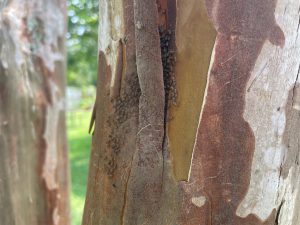
When summer temperatures rise, the bark of crape myrtles starts peeling off. There are several species of trees, including river birch and gumbo limbo, which lose bark in large strips. South Florida’s gumbo limbo is nicknamed the “tourist tree,” as the peeling bark resembles the after-effects of a major sunburn. Under the older bark is a smooth layer of unblemished bark, ready to protect the tree from next year’s harsh weather and diseases.

Every now and then, if you pull back bark from a tree, you might be met by a bug or two. Sometimes, you might be surprised by a large collection of insects moving in unison with one another. Known as bark lice (Archipsocus nomas), or tree cattle—for their herd-like movements—these tiny insects are common among local trees, including oaks and palms. We get calls routinely from homeowners concerned by a potential infestation, wanting to know how to rid their trees of the bugs. Luckily in this situation, there is nothing really to be done, as bark lice are harmless.

Also known as psocids, tree cattle are related to book lice, which can be found in old collections of paper or in cereals and grains. Tree cattle/bark lice are their outdoor cousins, helpfully dining on fungi, moss, algae, and dead insects. They will sometimes form webs beneath tree bark to protect themselves from predators like birds and insects. The webbing can be unsightly but is also harmless to the tree. If you don’t like the look of them, the webs can be sprayed off with a hose. Once you get past the initial creepy factor, tree cattle are pretty fascinating critters. Let us know if you’ve seen any this year!
 8
8
